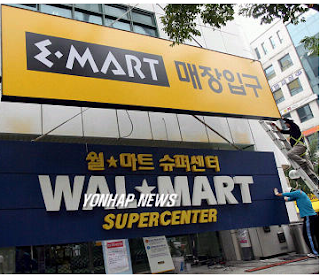On May 22nd, 2006, a massive super store firm, Wal-Mart, withdrew from South Korea. Before Wal-Mart, another massive super store firm, Carrefour, also removed from South Korea. However, both firms are successfully operating in other countries, and they are very big global brand:
If there's no Wal-Mart store near you, just wait. If you shop at Wal-Mart, expect your store to get bigger or a new store to open even closer. The chain plans to expand from 3,400 U.S. locations today? half of them in the South? to a nationwide network approaching 5,000 stores in five years.
Carrefour S.A. is an international hypermarket chain headquartered in Courcouronnes, France. It is one of the largest hypermarket chains in the world (with 1,395 hypermarkets at the end of 2009, the second largest retail group in the world in terms of revenue and third largest in profit after Wal-Mart and Tesco.)
But in Korea, these superstores were replaced with a firm called “E-Mart.” E-Mart has similar operation system with Wal-Mart, which pursues a low price orientation to dominate the discount retail sector. Then, what are the reasons of their failure in Korea? Another dubious question comes out on mind: Can Wal-Mart get any bigger? Unfortunately, yes.
But in Korea, these superstores were replaced with a firm called “E-Mart.” E-Mart has similar operation system with Wal-Mart, which pursues a low price orientation to dominate the discount retail sector. Then, what are the reasons of their failure in Korea? Another dubious question comes out on mind: Can Wal-Mart get any bigger? Unfortunately, yes.
Before stating the reasons of failure, we should know the characteristics of Wal-Mart in the United States, which were successful. The tactic that Wal-Mart used to expand in the United States was building a huge, warehouse look store in rural area, and then, spread out its store to nearby cities to form retail clusters. So, Wal-Mart used same tactic in Korea, making huge stores in suburbanized area. The places, Wal-Mart chose to make stores, did not matched with Korean consumers’ life style and shopping habits. Korean consumers prefer to purchase small amounts frequently than buying large volume at once, because they want fresh food and beverages than dry goods:
Wal-Mart and Carrefour, which entered the country in 1996, put off South Korean consumers by sticking to Western marketing strategies that concentrated on dry goods, from electronics to clothing, while their local rivals focused on food and beverages, the segment that specialists say attracts South Koreans to hypermarkets.
So, Korean consumers prefer to go to a department store, where it has good accessibility. This means that people like to go to department stores which have convenient transportation system. And urbanized areas have good transportation system. Wal-Mart did not concern shopping custom of Korea.
Not only the tactic but also bad timing made Wal-Mart to choose bad locations in Korea. Major other retailers, E-Mart and Homeplus, had already built their stores in urban area. It blocked Wal-Mart to build their stores in commercial area. This situation is also seen in Germany, where Wal-Mart failed to succeed either. In Germany, Aldi chain occupied favorable places for department stores; eventually, Wal-Mart could earn undesirable places:
Germany also provides a lesson in the perils of buying existing chains. Wal-Mart’s purchase of Wertkauf and Interspar saddled it with stores in undesirable locations. The Wiesbaden outlet is worlds away from a squeaky-clean American Wal-Mart: nearby are a couple of sex shops. “These were some of the least attractive of the big-box retailers out there,” said James Bacos, director of the retail and consumer goods practice at Mercer Management Consulting in Munich.
Bad timing was problem for Wal-Mart in Korea and Germany; but, we could also know that Wal-Mart was only interested in expansion without having enough information on each market.
Wal-Mart failed in Korea, because it did not concerned about differences on each countries’ cultures. The vice chairman of Wal-Mart said, “As we continue to focus our efforts where we can have the greatest impact on our growth strategy, it became increasingly clear that in South Korea’s current environment it would be difficult for us to reach the scale we desired.”
When we see the cases on Korea and Germany, it seems that Wal-Mart can’t expand anymore. Actually, it can. Wal-Mart can expand their industry in China, Mexico and Brazil, which have big market:
Wal-Mart did not change the names of the stores, which range from neighborhood grocers to large American-style hypermarkets. But with 295 stores in Brazil, Wal-Mart now ranks third in the market, after
Carrefour of France and the market leader, Companhia Brasileira de Distribução.
\
Also, Wal-Mart does not care much about its foreign stores carry the name derived from its founder. For example, in Japan, Wal-Mart took over Seiyu, but keep using name Seiyu, instead of using Wal-Mart. Over all, Wal-Mart is still expanding outside the United States:
Seventy percent of Wal-Mart’s international sales come from outlets with names like Asda in Britain, Seiyu in Japan or Bompreço in Brazil.



댓글 없음:
댓글 쓰기